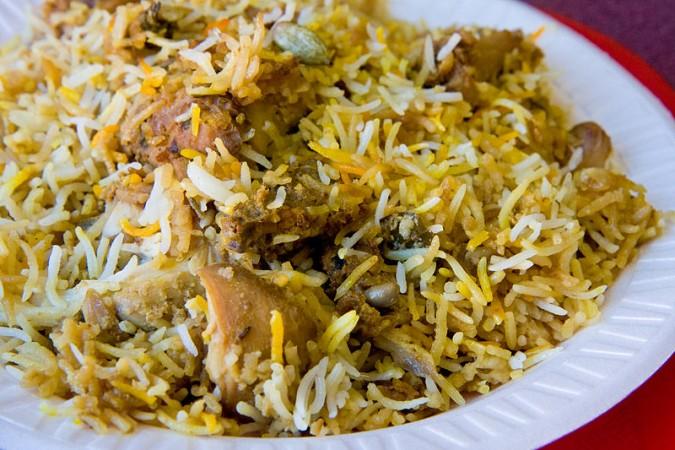
Get into festive cooking mode and make Biryani this month, because no Eid celebration is truly complete without huge pots of delicious, aromatic Biryanis served with love. Biryani was considered a royal dish, fit for kings and is said to be a favourite of emperors Akbar and Shah Jahan, occupying a prideful place in the kitchens of the Nawabs and Nizams of India.
As is the case with everything in India, Briyani too has many varieties and forms all over the country. Each has a unique background, story and taste, but all are equally mouth-watering; be it the Mughlai Biryani, the authentic Biryani brought to India by the Persians, the Lucknowi Biryani that titillated the taste buds of the Nawabs of Awadh, Dum Biryanis, now famous all over India, the masterminds behind which was the Nizams of Hyderabad, Malabar style Biryani with a delectable smell of banana leaf and coconut, created in God's own Kerala, the coastal innovation of prawn Biryani or the Sindhi beef Biryani, which is as much a part of the Indian culture, even if Sindh may not be a part of India anymore.
Mughlai Mutton Biryani
Mughlai cuisine, strongly influenced by Persian and Turkish flavours, is one that makes everyone's mouth water, and among the many dishes offered in this cuisine, Mughlai Mutton Biryani is a sumptuous and grand dish that is part of many traditional household recipes. Eid is not complete without some mouth watering mutton biryani in Mughlai Style.This recipe is itself a complete meal, rich and nutritious with healthy carbohydrates , protein and fat. Though this recipe involves considerable time in preparing, it will leave you licking your fingers.
Lucknowi Murgh Biryani
The Lucknowi Murgh Biryani, known as "Pukki" Biryani is very popular in India, especially in Delhi and Lucknow. The Mughal style of cooking left an indelible mark and gradually seeped into the Gangetic plains and led to the evolution of the Awadhi Biryani in Lucknow. The rice and chicken are seperately cooked and then layered together similar to Dumpukht style. In this recipe, the layered curried rice is prepared with Basmati rice and chicken is cooked with deliciously spicy ingredients.
Hyderabad Dum Biryani
The torchbearers of 'Biryani' revolution were Nizams of Hyderabad. Their kitchens experimented with flavours and came up with a unique variety of Biryani, now called the Hyderabadi 'Dum' Biryani'. Also known as Kutchi (or raw) Briyani, the cooking process does not adhere to the name Biryani in Farsi meaning 'fry before cooking'. The meat is marinated in a mixture of spices for a few hours, after which it is put in a Handi, over which a mixture of yogurt and rice is placed. The Handi is then sealed and cooked over low heat. Eventually, the meat and rice are Dum cooked, resulting in a Biryani that is very different flavour from Lucknowi Biryani. Although in theory, it is simple to make, it requires a lot of experience to create a carefully balanced equation of all the variables to make the perfect Hyderabad Biryani.
Malabar Biryani
Malabar biriyani or Thalassery Chicken Biriyani, the traditional Biriyani recipe of North Kerala, is an easy recipe for follow without compromising on the taste, making it the best dish to serve when guests are over. Without the use of much spice powders, Malabar Biriyani is normally made with Kaima Rice also known as Jeerakasaala Rice or Jeera Rice, which is approx half the size of Basmati Rice. It has a very nice aroma and a very unique taste that adds to the authenticity of Malabar Biriyani. There are various versions of the Malabar Biryani, the creation of which has been refined to an art by the Muslim cooks particularly - some just use green masalas with no spice powders and some with fried chicken, some with a trace amount of masala, and so on - and all are equally yummy.
Jhinga Biryani
Jhinga or prawns Biryani uses prawns instead of the usual meat or chicken and is one of the very popular rice recipes in India. The spices used in Jhinga Biryani make the rice very aromatic and teases the taste buds. Since this Biryani doesn't give off an excessive seafood odor, no one would ever believe that it is prawn Biryani until they dig in and find the prawns. At the same time, the prawn absorbs the masala well, making for a spicy, tangy and utterly delicious dish. This is one pot meal that is absolutely relished by all seas food lovers. Many use shrimp instead of prawns in this recipe as well.
Sindhi Biryani
A feast in its own right, Sindhi Biryani is a marvellous creation of layers of perfectly cooked goat (any meat) curry, beautiful rice and a fresh mix of tomato, herbs and chilli, all decorated with nuts and onion rings. As opposed to a regular Biryani, Sindhi Biryani, originating from the Sindh province of Pakistan, is more spicy and is enriched with an aroma of green mint, chilies and coriander. It strikes a perfect balance between the tastes and textures of rice, meat, and curry masala, which is fragrant with herbs, hot chiles, ginger, and other spices. The specialty of the recipes is that the is the curried goat and rice are cooked separately, and then steamed in layers, so that the sauce and juices drip into, but don't saturate, the fluffy grain. The result is a beautifully striated centerpiece that offers rice, spice, and meat in waves of astounding flavor.













!['It's not Mumbai traffic, it's air traffic': Suriya apologises to Mumbai media after paparazzi yelled At Him for making them wait for hours [Watch]](https://data1.ibtimes.co.in/en/full/806234/its-not-mumbai-traffic-its-air-traffic-suriya-apologises-mumbai-media-after-paparazzi.jpg?w=220&h=138)



